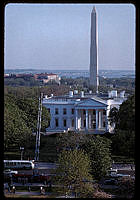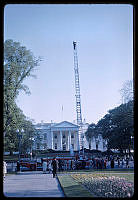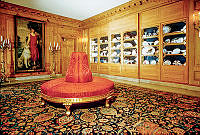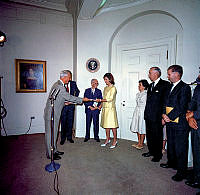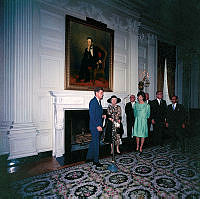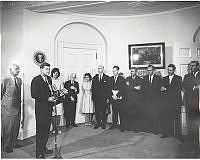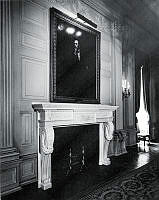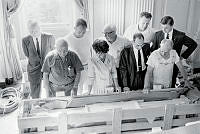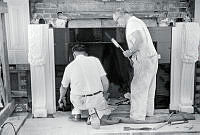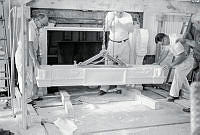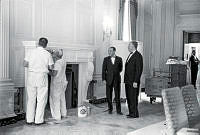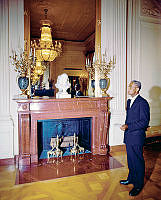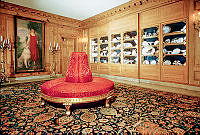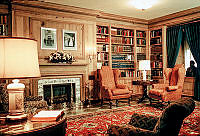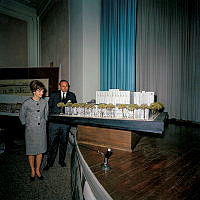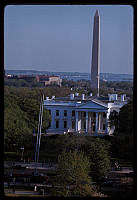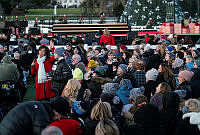The Hidden White House: The Truman Renovation, 1948-1952
Copyright © January 25, 2014 White House Historical Association. All rights reserved under international copyright conventions. No part of this article may be reproduced or utilized in any form or by any means, electronic or mechanical, including photocopying, recording, or by any information storage and retrieval system, without permission in writing from the publisher. Requests for reprint permissions should be addressed to books@whha.org
When Earvin Ruddick's family took him on the White House tour on his 90th birthday two years ago, he became one of the millions who troop through the mansion to marvel at the sumptuous Federal interiors with their marble mantels and hand-tooled paneling. But unlike the wide-eyed masses, Ruddick's glance at the fine woodwork was both knowing and familiar. After all, he'd seen this wood before. He'd carved it with his own hands 60 years earlier.
It was just another job, Ruddick told me recently. We had lots of jobs at the time. The White House stuff didn't mean much to us.
Lest his sentiments sound crass, an explanation is in order. In the years after WWII, Earvin Ruddick was a woodworker for Knipp & Co., one of the dozens of contractors hired as part of Harry Truman's rebuilding of the executive mansion. By the time the Truman's moved into the White House in 1945, decades of ill-conceived renovations, coupled with the lack of foundations beneath the houses interior brick walls, had left it on the verge of literal collapse. After summoning a small army civil engineers to investigate the mansions trembling floors and swaying chandeliers, Truman moved his family across the street to Blair House while the White House stood for a complete overhaul.
That's where Mr. Ruddick entered the picture and, in another sense, where I enter it, too.
In November, St. Martins Press published my book The Hidden White House, the first full-length account of the White Houses near-collapse and complete reconstruction. The books research and writing consumed nearly three years of my life about the same amount of time it took hundreds of workmen to rebuild the White House in actual fact. I had few regrets sifting through the hundreds of pages of archival material I'd found (in my business, paperwork is a good thing.) If I had a misgiving, it was that I'd come to the story too late to speak with any of the men who'd done the work between 1949 and 1952. The architects and engineers seasoned professionals in their 60s and 70s at the time were of course long gone. The workmen were younger, I knew, a handful of them possibly still with us. But the newspapers failed to mention the names of such men, and the contractors files were missing personnel records. With no prospects for a firsthand source, I did my best without, turning in my book about the White House renovation.
As the photos here show, it was quite a job. Refusing to apply yet another bandage to the houses structural problems as past presidents had done, Truman pushed for the big fix: The digging of 22-foot-deep foundations below the existing footings and a steel frame skeleton for the interior. What was called a renovation was in truth a gut job: Workmen tore out everything inside of the White Houses outer stone walls. What became of those tons of material much of which was buried in a pit is the stuff of controversy. But one aspect of the work was beyond reproach. Faced with the question of what to do with the mansions massive but badly cracked wooden floor beams, Truman had an inspired idea: He wanted it milled down and carved into decorative panels and molding for the ground-floor rooms.
That was work done by a crew of men employed by Knipp & Co. One of those men was Earvin Ruddick, whose daughter e-mailed me the day after her father received my book as a Christmas present. She gave me his telephone number. I called the following day.
There were about 12-14 of us working on the White House, Ruddick remembered of those hectic days in 1951, when trucks hauled the foot-thick beams up from D.C. to Knipp's warehouse in South Baltimore. This was the timber that James Hoban put into the house in 1817, after the British had burned the place down. It was Georgia Pine longleaf and very hard, Ruddick said. But through age, it had gotten very brittle. A lot of the beams were splintered. We had to take all the nails out and cut out the bad parts. We used a straight-line saw and cut it all up into molding.
At the time, Ruddick didn't get to see where his molding ended up. But during the tour his family took him on recently, he recognized some of it in the Vermeil Room.
Even though the White House was just another job to him all those years ago, I asked Ruddick if his feelings had changed over time. How does it feel to have one's handiwork sitting in the world's most famous house? "Oh," he said, "I'm very proud of it now."
In this respect, Mr. Ruddick and I share more than just a connection to the White House. We both know what its like to toil on something long and frustrating, yet produce a useful result. The difference, of course, is that my work is just a book; Mr. Ruddick's handiwork is now part of history.














